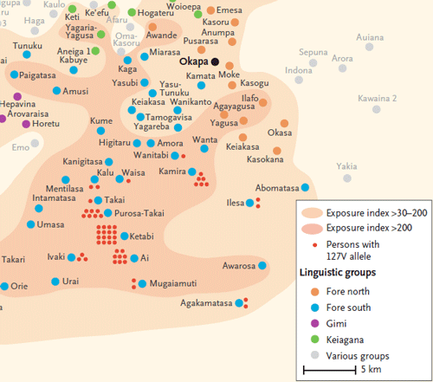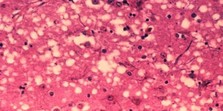
Origination/Discovery:
- Kuru map (6)
- Found in the eastern highlands of Papua New Guinea (7)
- In the South Pacific, just north of Australia (4)
- In the late 1950s, colonization of these uncharted areas led to the first recognition of the disease symptoms (4)
- Explorers also noticed that ritual cannibalism was part of the Fore culture; this later was found to be the cause of Kuru transmission (4)
- In March of 1957, Carleton Gajdusek was introduced to the disease by local medical officer Vin Zigas and then took the lead on the investigation (4)
- Gajdusek joined forces with Michael Alpers soon after and they began collecting brain autopsy samples from the victims back to the U.S. and infected Chimpanzee brains to observe if the disease was transmissible in this way (8)

Pathology:
- Microscopic view of cow brain tissue with vacuolation and sponge-like appearance from bovine spongiform encephalopathy (11)
- Caused by prions (9)
- Origin of the outbreak was due to the cannibalism of the Fore people (had a ritual to eat their family post-mortem) (8)
- Kuru prions target the cerebellum (10)
- The symptoms present in 3 stages (as reported by Gadjusek): (10)
- ambulant stage: unsteadiness of stance, gait, voice, hands, and eyes; deterioration of speech; tremor; shivering; in- coordination in lower extremities that moves slowly upward; and dysarthria (slurring of speech)
- sedentary stage: patient can no longer walk without support, more severe tremors and ataxia (loss of coordination of the muscles), shock-like muscle jerks, emotional lability, outbursts of laughter, depression, and mental slowing (it is important to note that muscle degeneration has not occurred in this stage, and tendon reflexes are usually still normal)
- terminal stage: marked by the patient’s inability to sit up without support; more severe ataxia (loss of muscle coordination), tremor, and dysarthria (slurring of speech); urinary and fecal incontinence; difficulty swallowing (dysphagia); and deep ulcerations appear (Gadjusek, 1973).There is no known cure but since colonization of the eastern highlands of PNG, the disease seems to have subsided (8)
Conservation Status:
